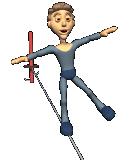Big rigs carry the big top for Carson & Barnes Circus
By William Childress
Road King Magazine
Every spring since 1940, a huge, fascinating show has taken to America's highways. With 400 people and dozens of animal stars, this rolling "theater" – the venerable five-ring Carson & Barnes Circus – tours from March to November in 30 big rigs and 50 RVs, coaches, pickups and cars.
The trucks range from 1985 to 1990 models. One is a completely equipped garage for repairs on the road. Six mechanics, led by Mechanical Superintendent Randy Fulton, keep the vehicles in such top shape that inspectors often compliment them. "One thing we want folks to know is we are not a carnival," says Fulton. "We're a circus, and a family. Unfortunately, if some carny gets bad press, we're tarred by the same brush."
And get this, retired truckers: They'll happily help you run away and join the circus – as a driver. Many men and women have realized a childhood dream this way. Fulton says they also teach inexperienced drivers how to drive. Call (831) 582-4375 for details.
Ah, the romance of the circus.
Even in our sofa-bound age of TV trash, this marvelous show, one of the last of its kind, still pulls them in. Started as an actual dog and pony show in 1937 by "Mister Circus," the late D.R. Miller, the circus' home since 1940 has been Hugo, Okla. From this central location, its trucks – loaded with everything from elephants to huge drums that roll out pre-folded tons of canvas – start their long convoys in March, heading west in the colder months, east in the warmer ones.
The circus is not just a job, it's a life, and if you stay in it, you love it. "We'd better," laughs a pretty female clown. "It's the hardest work any of us will ever do."
The biggest worry? Weather. The circus is a show, and the show must go on. If a major storm hits a town before the circus arrives, elephants are often harnessed to pull the big rigs through deep mud.
This traveling village has its own cooking facilities, power generators and medical personnel. But it can be set up within two hours of arriving at its site – an amazing feat eagerly watched by local residents.
The average mind can scarcely conceive of the complexity of getting all the animals, people and vehicles on the road at once, and then transformed from a caravan into a show in a couple of hours. That's why the U.S. Army, prior to WWII, sent officials to study the way Carson & Barnes achieved the impossible – raising a 900-foot tent, performing two shows, then repacking for another show in another town – all in just 24 hours! The Army even analyzed the way they fed hundreds of people and animals – a truly gargantuan task.
Like an army, the circus is almost continuously on the move, so they must prepare for and deal with wear and tear on vehicles. "We cover half the country per year," says spokeswoman Alfrieda Wilkins. "In 2000, for example, we showed mostly in the East and South."
Each year, some 230 towns and cities play host to the Carson & Barnes Circus for one day only. Why just one day? "It's just tradition. The Carson & Barnes Circus has been on the road for 60 years, and it has always operated on one-night stands," says a circus official.
Given the large number of trucks, employee RVs, trailers, generators, animal feed trucks and other equipment that must be moved, this is little short of amazing. The Big Top alone, with its five rings, takes up a space the size of three football fields – and it's all taken down, packed up and on its way as soon as the last show ends.
So when circus posters say "One Day Only" – they mean it. And kids have to be sure that their parents or grandparents know this, or they'll miss out on one of America's grandest traditions, a day at the circus.
Controversy stalks circuses
Running the length of a city block, the Carson & Barnes Circus parade recalls the pomp, majesty and color of circus history and features the largest traveling menagerie on earth. Carson & Barnes treats its animals extremely well, and they perform well. Some female elephants have been with the circus nearly 50 years.
"In England, several animal-rights groups commissioned a study to 'prove' that circus animals were mistreated," says Wilkins. "When it was completed, the opposite happened. The independent experts commissioned for the study unanimously stated that circus animals were not only better cared for, but lived longer than either zoo animals or animals in the wild."
The USDA Animal and Plant Inspection Service, Animal Care Division, inspects the animals annually. The USDA has documented inspections of 49 different animals, including 16 elephants and two "ligers," crosses between lions and tigers and a great favorite with crowds. According to spokesperson Laura Sanchez, the USDA had "abuses" reported only three times since 1986 by animal rights activists. "The first, we ruled 'no violation' the second we declined to pursue, and the third is still being looked at."
Carson & Barnes animals are examined by various USDA vets at many sites along the road, from Santa Fe, N.M., to Pittsburgh. All the animals are carefully supervised, and ailments aren't all that's reported. Elephants, for instance, must have regular pedicures to avoid split toes. All the animals get TB shots and other needed medicines.
As anyone dependent on animals for .a livelihood knows, it makes no sense to mistreat creatures that work for you. Says one .of the animal handlers, "Animal-rights activists would know this if they weren't so full of themselves and their own warped ideas. Misguided and misinformed people donate funds to keep these fanatics going. They claim circus animals are drugged, starved and beaten. We invite the public to come and see for themselves how well we treat our animals."
Carson & Barnes not only has the biggest elephant herd in captivity (about 30, of which 17 travel with the show in special elephant trucks), but the family that owns the circus has long been active in trying to save endangered species. In 1999, their first baby elephant was born from the breeding program they share with the world-renowned Elephant Program at Washington Park Zoo in Portland, Ore.
Animal handlers have their share of stories. A couple of decades ago, the circus' bull elephant pulled loose from the heavy stake to which he was secured, then helped a couple of his sweeties uproot theirs. Away the three went, trumpeting in freedom, through the rough hill country of the surrounding Ozarks. Somewhere in the night, they plunged over a bluff – and the very costly bull broke his neck and died. The two cows survived, because they fell on the bull.
Another time, a tiger got loose. But being totally unprepared for the wide, strange world outside his cage, he ran into a barn and hid. Handlers took some food into him, and after a while, led him docilely back to his cage.
The circus is in town!
Floods and heavy rains are also problems. More than once, Carson & Barnes has helped people caught in floods to safety. Sometimes the grounds where they're scheduled to erect the Big Top are seas of mud that won't hold the 6-foot wooden "pegs" to which the tent's guy-ropes are tied. That's when the truck drivers crank their engines and circle the big rigs at the perimeter of the tent, and crews secure the ropes to the trucks. Ingenuity abounds in the circus, because it has to.
Like Santa Claus, and just as quietly, the vanguard of the circus – the tent poles and tent trucks – reaches town before dawn. Then the elephants arrive, with five that can wear harnesses and pull trucks out of or through deep mud. They will help erect the Big Top – a sight that thrills early-rising circus watchers, many of them children.
The cook truck and dining tent are parked and set up, followed by the water truck (extremely dusty places must be sprinkled, plus animals need water), the generator truck, and the ingenious tent truck.
This big box on wheels is equipped with giant rollers. The immense tents – made of plastic-coated canvas and weighing many tons – are pulled off by dozens of roustabouts as the huge drums revolve, powered by PTOs, and the truck inches forward.
Once the tent is laid out, the elephants are brought in and the raising of the tent – 61,230 square-feet of fireproof polyvinyl – begins, both inside and outside. This alone is a fabulous sight that no child or adult should miss! Weather does not stop the tent crews, and the Big Top often goes up over muddy acres. Does this dismay circus goers?
"No way!" laughs Fulton, who is in charge of all vehicles. "Some of them take off their shoes and have a ball in the mud. I couldn't believe it the first time I saw it."
Meanwhile, the trucks line up and park. They serve double-duty as ticket booths, concession stands or dressing rooms. The minute the last show ends at 9:30, truck engines roar, harnessed elephants are moved into place, and in two short hours, a city under canvas rolls on once more. *
--------------------------------------------------------------------------------
Animals, Exotic Performers Keep Circus Going
The Public is free to walk around and view Carson& Barnes' animals – elephants, zebras, lions, tigers, a pygmy hippo, camels and llamas. (Llamas sometimes spit on people who get too close. But who ever died from a little llama spit?)
But it's not a good idea to raise your toddler in front of the tiger's cage and say, "Pet the big kitty!" which a shocked circus employee saw a mother do. "They're well fed and not hungry," he warned her, "but they're still wild animals. Keep your children at a respectful distance."
Although television killed off most of the big rolling circuses in the 1960s, including the historic "Greatest Show on Earth," Carson & Barnes is doing very well indeed, perhaps because it's the only big show left. "We're in demand," says one performer proudly, walking off to join his troupe.
Carson & Barnes has succeeded where others failed by using good business practices and by importing great acts from abroad, like the famous Chinese Acrobats who always bring down the house. The 150 performers include 100 from China, Peru, Romania, Russia and Mexico, all superbly skilled in their arts. In addition, state-of-the-art lighting and sound shows attract younger visitors; that circus music can also set their feet to moving. For more information, visit /www.carsonbarnescircus.com.
Tuesday, August 19, 2008
Run Away With the Circus
Subscribe to:
Post Comments (Atom)














0 comments:
Post a Comment